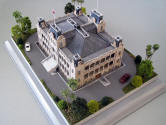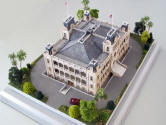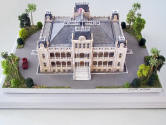|
The
IOLANI PALACE is located in Honolulu on the island of Oahu and is the only
royal palace in the United States. It was the official residence of
the last ruling monarchs of the Kingdom of Hawaii - King Kalakaua and his
sister Queen Liliuokalani.
But there had been a previous Iolani Palace
at this location. The name for the previous palace was "Hale Ali'l.
In 1863 Kamehameha V changed the name of the palace to Iolani Palace (bird
of Heaven) to honor his deceasded brother Kamehameha IV. When King
Kalakaua came to the throne in 1874, that old palace was a coral block
building in great disrepair, so he had it demolished and commissioned a new
Iolani Palace, which was modeled after the grand palaces he had seen during
a trip to Europe.
Begun in 1879, the Palace we know today was
designed in a style referred to as "American Florentine", a unique style
characterized by features of Italian Renaissance architecture with elements
of Hawaiian architecture. Iolani Palace is the only building in the
world constructed in the American Florentine style. Three different
architects - Thomas J. Baker, Charles J. Wall, and Isaac Moore, worked on
the palace - with Baker's designs being the ones used primarily for the
building. The cornerstone was laid December 31, 1879. The
large palace was built of brick with concrete facing and had four corner
towers and two center towers with double lanais (roofed, open sided
verandas) encircling the building on the first and second floors. It
was completed in 1882 and cost over $340,000 - a vast fortune at that time.
Although Kalakaua had already ruled for 9
years, he held a huge formal European-style coronation ceremony in 1883.
The coronation pavilion was later moved to the southwest corner of the
palace grounds and converted to a bandstand for the Royal Hawaiian Band.
When the palace opened, it was considered
one of the finest palaces in the world. And it had indoor plumbing,
electric lighting, and an early telephone, all before the White House did.
After the Hawaiian monarchy was overthrown
in 1893, the palace was used as the capitol for the various Hawaiian
governments. In 1895, Queen Lili'uokalan had been forced to give up
her throne. She lived at her personal residence, Washington Place,
where she was arrested and t ried for aiding the short-lived attempt to
restore the monarchy. At her trial she was fined $5000 and sentenced
to five years hard labor. The sentence was later commuted but she was
restricted to one bedroom on the second floor of the palace and was allowed
one lady-in-waiting during the day, but no visitors. During this
period she spent her time making a beautiful quilt. Today the quilt is
on on display in the bedroom where she was confined.
During the palace's tenure as the capitol,
it was not maintained, and by the 1960's had fallen into complete
disrepair. In 1969 the State Government moved to a newly
constructed capitol building across from the Palace. After 87 years of
continuous use, Iolani Palace ceased to be the capitol of the Hawaiian
Islands.
In the 1970s, the Friends of Iolani Palace
oversaw an extensive restoration of the building. Completed in 1978,
the building had been meticulously restored to its former grander.
After this restoration, Iolani Palace was opened to the public as a museum.
Daily tours are now available and the wooden floors are so grand that
visitors are required to wear felt "booties" over their shoes when they are
in the building.
Today Iolani Palace is a National Historic
Landmark listed on the National Register of Historic Places and it is one of
3 places in Hawaii where the flag of Hawaii can officially fly alone without
the American flag.
|







